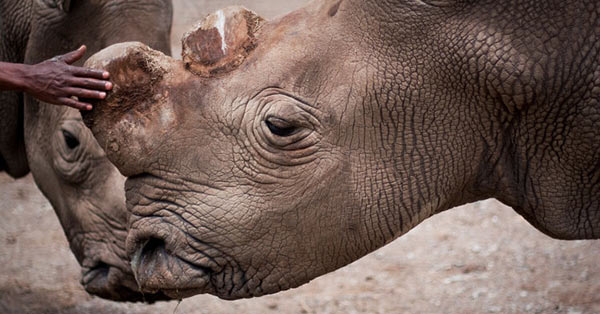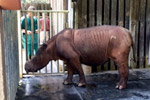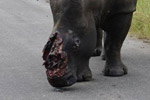Rhino conservation suffered another tragic setback this weekend with the sudden death of Suni, a male northern white rhinoceros (Ceratotherium simum cottoni) at the Ol Pejeta Conservancy in Kenya. Suni’s passing means there are only six northern white rhinos left in the world, and only one breeding male.
“Consequently the species now stands at the brink of complete extinction, a sorry testament to the greed of the human race,” wrote the Ol Pejeta Conservancy in a statement.
Suni was not killed by poachers like so many rhinos in Africa today, but was found dead in his enclosure. The Ol Pejeta Conservancy will conduct an autopsy to determine the cause of death. Suni was 34-years-old and the first northern white rhino to be born in captivity.
Northern white rhinos once roamed portions of Uganda, Chad, South Sudan, the Central African Republic, and the Democratic Republic of the Congo (DRC). The history of the species has already been one of near-misses. After the devastating rhino poaching crisis of the 1980s, the wild population was reduced to just 15 animals. However, this population eventually doubled, until rhino poaching for horn became rampant again in the mid-2000s. The last known northern white rhinos in the wild disappeared from Garamba National Park in the DRC around 2006. It is believed they were slaughtered by poachers.

Suni. Photo by: the Ol Pejeta Conservancy.
Today there are only six left, all in captivity: two at the San Diego Zoo Safari Park, one at Dvůr Králové Zoo—the only zoo to succeed at breeding the animals—and three in semi-captive conditions at Ol Pejeta Conservancy in Kenya.
“We will continue to do what we can to work with the remaining three animals on Ol Pejeta in the hope that our efforts will one day result in the successful birth of a northern white rhino calf,” said the Conservancy.
Northern white rhinos are generally considered a subspecies of white rhinos, however a 2010 paper argued that the subspecies should be raised to species level due to physical and genetic differences. The study has proven controversial and some conservationists suggest it might be best to breed the northern white rhinos with the southern subspecies in order to preserve at least a portion of their genetics.
White rhinos (Ceratotherium simum) remain the most populous on the planet with an estimated 20,000 individuals. However, they have also taken the biggest brunt of the current poaching crisis for rhino horns given their relative abundance.
As to the world’s other rhino species, two are on the brink of extinction. Only 58 Javan rhinos (Rhinoceros sondaicus) survive in a single protected area in Java, while the Sumatran rhino (Dicerorhinus sumatrensis) may be down to fewer than 100 individuals—and may be the world’s most imperiled rhino species given that its populations are highly-fragmented. The population of black rhinos (Diceros bicornis), which live alongside white rhinos in Africa, sits at around 5,000 individuals, while Indian rhinos (Rhinoceros unicornis) are at approximately 2,500.
Related articles
Photos: Czech Republic publicly burns confiscated rhino horns

(10/06/2014) Late last month, armed guards escorted officials marching 60 kilograms (132 pounds) of rhino horns to a pyre for burning. The event, at the Dvůr Králové Zoo in the Czech Republic, was the first public burning of rhino horns in Europe. The Czech Republic burned the horns, which came from a government stockpile as well as from past rhinos held at the zoo, in a bid to help conserve rhinos.
558 dead: rhino poaching in South Africa on track to exceed last year’s record
(07/14/2014) Poachers have butchered 558 rhinos in South Africa so far this year, approximately a hundred more animals than lost during the same time in 2013.
On the brink of extinction: Javan rhino has new enemy in invasive palm

(07/01/2014) The last of Indonesia’s critically endangered Javan rhinoceroses have survived poachers, rapid deforestation and life in the shadow of one of the archipelago’s most active volcanoes. But an invasive plant is now posing a new threat to the world’s rarest species of rhino.
Despite poaching, Indian rhino population jumps by 27 percent in eight years
(06/10/2014) The world’s stronghold for Indian rhinos—the state of Assam—has seen its population leap by 27 percent since 2006, despite a worsening epidemic of poaching that has also seen 156 rhinos killed during the same period. According to a new white paper, the population of Indian rhinos in Assam hit 2,544 this year.
Riddled with tumors: another blow to the Sumatran rhino species

(04/14/2014) Conservation for Sumatran rhinos suffered another blow last week, only days after Suci—one of only ten rhinos in captive breeding efforts—died at Cincinnati Zoo. Scientists in the Malaysian state of Sabah revealed that a newly captured female, Iman, suffers from an assortment of tumors in her uterus, hugely complicating reproduction efforts.
Death of young Sumatran rhino shouldn’t discourage captive breeding efforts say conservationists

(04/01/2014) Just over two weeks ago, conservationists in the Malaysian state of Sabah managed to finally catch a wild Sumatran rhino female after months of failed attempts. But following such hopeful events, comes bad news thousands of miles away: a young female rhino, named Suci, died over the weekend at the Cincinnati Zoo.
Meet Iman: the Sumatran rhino’s newest hope for survival

(03/24/2014) Hopes for one of the world’s most imperiled megafauna rose this month when wildlife conservationists succeeded in catching a female Sumatran rhino named Iman in the Malaysian state of Sabah. The female, which experts believe to be fertile, has since been successfully transferred via helicopter to the Borneo Rhino Sanctuary where experts plan to mate her with the local male, Tam. Located in Tabin Wildlife Reserve, the Borneo Rhino Sanctuary is an uncompleted semi-wild enclosure and home to one of several last-ditch efforts to save the vanishing species from extinction.
Howard G. Buffett puts $24M toward saving rhinos
(03/21/2014) Howard G. Buffett, the son of Berkshire Hathaway chairman Warren Buffett, has pledged $23.7 million to South African National Parks to help fight rhino poaching in Kruger National Park, reports Reuters.
Conservationists catch wild Sumatran rhino, raising hope for world’s most endangered rhinoceros

(03/12/2014) Conservationists have succeeded in catching a wild Sumatran rhino in the Malaysia state of Sabah in Borneo, according to local media reports. Officials are currently transferring the rhino, an unnamed female, to a rhino sanctuary in Tabin National Park where experts will attempt to mate it with the resident male, Tam. The Sumatran rhino (Dicerorhinus sumatrensis) is one of the world’s most imperiled species with less than 100 individuals left.
Rhino with bullet in its brain and hacked off horn wanders for days before being put down

(03/05/2014) Last week, visitors in Kruger National Park came on a horrifying sight of the poaching trade: a rhino, still alive, with its horn and part of its face chopped off. The gruesome photo of the young rhino went viral and sent South African authorities scrambling. Five days after the sighting, South African National Parks (SANParks) has announced they found the rhino and put it out of its misery.